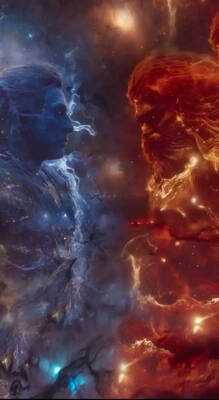 A New Era in Indian Mythology
A New Era in Indian Mythology
A palpable silence envelops the audience when something monumental graces the screen, and that was precisely the atmosphere when the teaser for Ramayana was unveiled. Instantly, viewers are transported into a realm filled with fiery arrows, majestic chariots, and divine figures depicted with such clarity that it feels almost sacrilegious to blink. The collaboration of Hans Zimmer's orchestral brilliance with AR Rahman's musical genius is nothing short of a cinematic triumph.
However, the real astonishment stemmed from more than just stunning visuals. It signified a pivotal moment for Indian cinema, showcasing its entry into the elite league of mythological storytelling, equipped with cutting-edge CGI and VFX.
This remarkable moment didn’t materialize overnight.
Let’s take a step back to 2006, a time when flip phones were still in vogue and Hrithik Roshan was making headlines in Krrish, donning a black trench coat and embodying hope. While it may seem dated now, Krrish marked a significant milestone as Bollywood's first serious attempt at the superhero genre, bringing CGI into the limelight like never before. The effects may appear rudimentary by today’s standards, but they resonated with audiences because they felt ambitious. For the first time, Indian viewers witnessed a home-grown hero defying gravity, and that was enough to ignite interest.
Fast forward to 2011, when Shah Rukh Khan introduced Ra.One, a sci-fi extravaganza that not only pushed limits but also redefined them. With DNEG, the Oscar-winning VFX studio behind films like ‘Dune’ and now ‘Ramayana’, Ra.One promised a tech-infused spectacle featuring digital villains and gaming realms. Although it was chaotic and somewhat perplexing, it brought Bollywood dangerously close to Hollywood standards. It wasn’t flawless, but its daring nature was enough to shift the paradigm.
If Krrish ignited the spark and Ra.One added fuel, Baahubali was the explosion. SS Rajamouli’s two-part saga (2015, 2017) didn’t just shatter records; it redefined the visual landscape of Indian cinema. With grand palaces, cascading fortresses, and vast armies, all rendered in breathtaking CGI, Baahubali set a new standard. The meticulous detail—from war elephants to flaming arrows—made every frame feel like a moving masterpiece. More importantly, it grounded its visual effects in emotional storytelling, making viewers genuinely invested in the battles.
Not every film needs gods and demons to showcase impressive VFX. Take War (2019), for instance—Hrithik Roshan returns, this time trading his cape for aviator shades and thrilling stunts. While it may not be heavily fantasy-oriented, War utilized VFX to enhance realism, featuring breathtaking bike chases and explosive sequences that felt meticulously crafted. This marked a significant shift: VFX was no longer reserved for epic tales; it became a staple in high-budget Bollywood productions.
Then came Brahmastra (2022), a film that sparked conversations even before its release. Ayan Mukerji took the bold step of merging Hindu mythology with contemporary fantasy, resulting in a visually stunning experience. With contributions from international studios like DNEG, the film introduced elemental effects that felt both innovative and culturally significant. Suddenly, Indian audiences were immersed in a cinematic universe filled with astras and avatars, making spirituality appear captivating.
By late 2022, RRR had already made waves, but its audacity propelled it into global cult status. Where else could you witness a man running through flames alongside a tiger and leaping off a bridge with another person on his shoulders, all while maintaining believability? The unapologetic use of CGI was a game-changer, and it resonated with international audiences, earning accolades for its ‘chaotic brilliance.’ Here, VFX transcended being a mere tool; it became a character in its own right.
Returning to Ramayana, the teaser suggests that this is not your typical mythological drama. Everything about the project exudes grandeur. DNEG's involvement is unsurprising, as they have become integral to India’s visual evolution. With Hans Zimmer composing the score, this project receives international acclaim, while AR Rahman adds a touch of legacy. From what has been revealed, Ramayana aims not only for visual brilliance but also for emotional depth, where light and energy intertwine, creating a sacred atmosphere.
Looking ahead, there’s no turning back. Bollywood’s relationship with VFX has matured, evolving from a novelty to a vital storytelling instrument. What began with basic effects in Krrish has transformed into a powerful, poetic, and globally relevant medium.
The exciting range of genres—from action thrillers to ancient epics and experimental sci-fi—indicates that the future is bright. With studios like DNEG, Red Chillies VFX, and Phantom FX at the forefront, the horizon looks pixel-perfect.
So, whether you’re a fan of fantasy, mythology, or simply enjoy watching tigers leap in slow motion, stay tuned. The saga of VFX in Bollywood is just beginning.